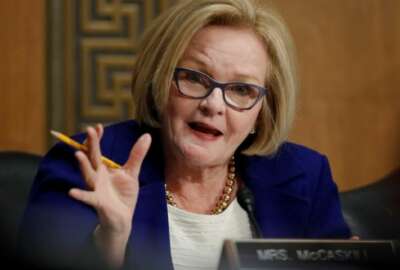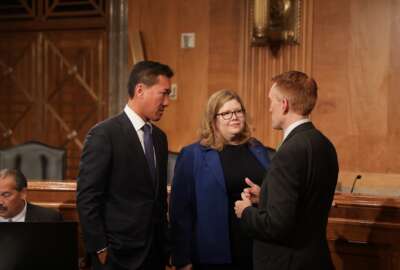
Bill authorizing government reorganization now has a House companion
The Senate Homeland Security and Governmental Affairs Committee is also expected to take up legislation authorizing a government reorganization next week.
Best listening experience is on Chrome, Firefox or Safari. Subscribe to Federal Drive’s daily audio interviews on Apple Podcasts or PodcastOne.
Lawmakers are still offering mixed messages on where they stand on the Trump administration’s proposed government reorganization. Some members are prepared to give the Office of Management and Budget the initial authority it needs to move forward, while others are using appropriations language to throw roadblocks in the way.
Rep. Jody Hice (R-Ga.) last week introduced legislation that would give the OMB the authority it needs to merge, transfer, consolidate an independent regulatory agency and its functions — or abolish an agency altogether.
House Oversight and Government Reform Government Operations Subcommittee Chairman Mark Meadows (R-N.C.) and Rep. Paul Mitchell (R-Mich.) are co-sponsors of the legislation.
Hice’s bill, the Reforming Government Act of 2018, is a companion to the legislation Senate Homeland Security and Governmental Affairs Committee Chairman Ron Johnson (R-Wis.) and subcommittee Chairman James Lankford (R-Okla.) introduced back in June.
It would give OMB two years to transmit an official government “efficiency-enhancing” plan to Congress, which must show how it will decrease the number of federal agencies and bring back cost savings.
The Senate Homeland Security and Governmental Affairs Committee is scheduled to take up the government reorganization bill at a markup next Wednesday.
Though the legislation is on the agenda, the committee has a history of only bringing forth the bills that leadership believes will get a successful vote on markup day.
Democrats on the Senate committee have been disappointed that OMB couldn’t provide more details about the origin of many of these reorganization proposals.
OMB Deputy Director for Management Margaret Weichert has said the administration identified 10-to-12 proposals from its reorganization plan that it can accomplish without Congress, though she wouldn’t — at least publicly — specify what many of those proposals were.
At the same time, Congress is also broadly complicating the administration’s reorganization plans. Lawmakers included a provision in the 2018 omnibus spending package that prevented agencies from appropriations to “increase, eliminate or reduce funding for a program, project or activity” without earning congressional approval first.
Similar provisions have made their way into appropriations bills for 2019, some of which have already passed Congress.
Financial services and general government appropriations committees, which would have jurisdiction over the administration’s proposed reorganization of the Office of Personnel Management and General Services Administration, include similar language in 2019 draft bills.
Joint statements from House and Senate conferees on both 2019 minibuses to date are littered references to the Trump administration’s reorganization proposals, but most express confusion about OMB’s intention or goals.
“The conferees are perplexed as to why there was no notification or discussion with members of Congress and committee staffs on an action of this magnitude that crosses multiple subcommittees’ jurisdiction,” House and Senate members wrote in a joint statement on the energy and water development, legislative branch and military construction and veterans affairs minibus.
“The conferees are opposed to the reorganization,” the conferees added, referencing the administration’s proposed move of the Army Corps of Engineers’ civil works program to the Transportation and Interior Departments.
‘We need to get the mindset that we can do this’
Meanwhile, several good government groups see a prime opportunity to move — now — on many of the opportunities and challenges the Trump administration outlined in the President’s Management Agenda to modernize the civil service.
“We need to get the mindset that we can do this,” Tina Sung, vice president for Federal Executive Networks at the Partnership for Public Service, said Thursday during a panel discussion at a Government Executive event on government reorganization in Washington. “We actually know what needs to be done since first the Volcker report in 1989. We need to focus our minds that people matter. We have to focus our minds, our attention and the discipline of execution to get it done.”
But it’s more difficult to stop admiring the problems with a federal personnel system built nearly 40 years ago and get something done when the average rank-and file employee has difficulty finding the time or the opportunity to work on the ground level on the administration’s workforce modernization efforts.
“They didn’t socialize this,” Bill Valdez, president of the Senior Executives Association, said of the PMA and government reorg plan. “They didn’t build a coalition behind it, both on Capitol Hill but also with the American public, about why these reforms were needed. Without that coalition building, without that stakeholder involvement, you can’t implement any kind of dramatic agency reform or institutional change.”
SEA, along with the Partnership and Volcker Alliance, are trying build their own coalition focused on improvements government could make the Senior Executive Service. They recently announced their plans to share their policy ideas with the administration and lawmakers.
The National Academy of Public Administration next week will release a follow-up to a report they released last year on civil service modernization. The new report will describe more specific use cases and ideas for modernizing the civil service, said Terry Gerton, the organization’s president.
Copyright © 2024 Federal News Network. All rights reserved. This website is not intended for users located within the European Economic Area.
Nicole Ogrysko is a reporter for Federal News Network focusing on the federal workforce and federal pay and benefits.
Follow @nogryskoWFED
Related Stories






